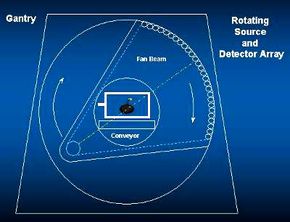Check Your Bags: CT Scanners
The first security check that your checked bags go through depends on the airport. In the United States, most major airports have a computer tomography (CT) scanner. A CT scanner is a hollow tube that surrounds your bag. The X-ray mechanism revolves slowly around it, bombarding it with X-rays and recording the resulting data. The CT scanner uses all of this data to create a very detailed tomogram (slice) of the bag. The scanner is able to calculate the mass and density of individual objects in your bag based on this tomogram. If an object's mass/density falls within the range of a dangerous material, the CT scanner warns the operator of a potential hazardous object.
CT scanners are slow compared to other types of baggage-scanning systems. Because of this, they are not used to check every bag. Instead, only bags that the computer flags as "suspicious" are checked. These flags are triggered by any anomaly that shows up in the reservation or check-in process. For example, if a person buys a one-way ticket and pays cash, this is considered atypical and could cause the computer to flag that person. When this happens, that person's checked bags are immediately sent through the CT scanner, which is usually located somewhere near the ticketing counter.
Advertisement
In most other countries, particularly in Europe, all baggage is run through a scanning system. These systems are basically larger versions of the X-ray system used for carry-on items. The main differences are that they are high-speed, automated machines integrated into the normal baggage-handling system and the KVP range of the X-rays is higher.
With all of these detectors, scanners and sniffers, it's pretty obvious that you're not allowed take a gun or bomb on a plane. But what else is prohibited?
